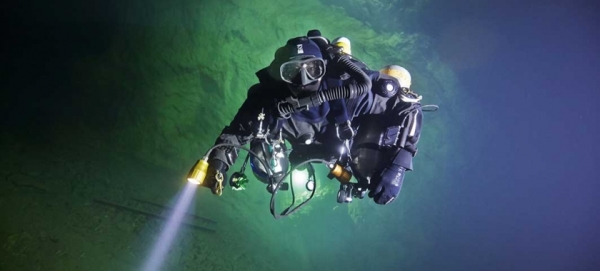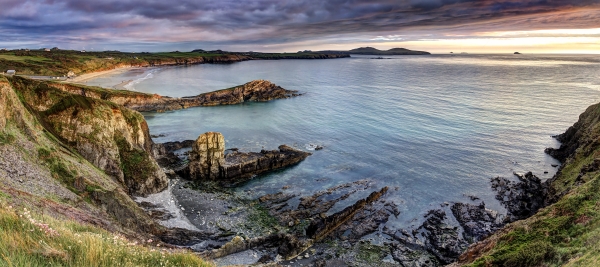This content has been archived. It may no longer be relevant
Blue Abyss will be the most comprehensive extreme environment research and training facility of its kind. Designed to support the commercial diving, submersible, human spaceflight and human life science sectors. Blue Abyss is scheduled to be fully operational by late 2018. In the build up to this momentous occasion, the Blue Abyss Vision 2020 series has been launched.
What is Blue Abyss Vision 2020?
Blue Abyss Vision 2020 is a visionary concept where through the use of fictitious reporting it provides a window into its future. And trust us, the view is pretty exciting from where we’re standing (or diving).
It’s designed to show in a very real way, the possibilities that Blue Abyss can give us outside the walls of the 50m dive pool. Blue Abyss is concerned with ‘pushing the boundaries’ in all areas. Research and development are key to the project and Blue Abyss Vision 2020 is a way of showing people what kinds of exciting new science and technology can come out of the project.
In its first report of the series, written by Andy Torbet (extreme explorer, TV presenter and Blue Abyss Consultant), the Blue Abyss Vision 2020 guides us through a phenomenally detailed ‘discovery’ that can be directly attributed to the existence of Blue Abyss.
The article lands in July 2020 with the discovery of one of the largest collections of Paleolithic art, found via an underwater entrance in a cave system, off the coast of West Wales, and raises the question ‘how long might this historic find have lain undiscovered?’
The circumstances of this find are not unique. In 1985 Henri Cosquer discovered what is now known as the appropriately named ‘Cosquer Cave’ – a cave harbouring breathtaking, extensive Paleolithic art. And, in the UK, the ‘Red Lady of Paviland’ was discovered in a cave in Pembrokeshire. But it does pose the question; what else is lying dormant, quietly and patiently waiting to be discovered in our marine cave systems, what could this teach us and more importantly how can we find and preserve such important historical information?
Blue Abyss Vision 2020 – new science and technology
High resolution Multi-Beam Sonar, Sub-Surface LiDar and Marine Deployed Ground Penetrating Radar (MDGPR) are all technologies created and improved at the Blue Abyss facility. In addition, a radical new underwater Remotely Operated Vehicle (ROV) nicknamed ‘The Octonaut’ was developed, which not only operates without a tether, but can transmit broadband quality real-time video through BlueComm transmission as it surveys the cave system.
Once 16 caves had been deemed worthy of further study by divers, Blue Abyss Vision 2020 suggests an expedition would be mounted from its own extreme environment research, development and training centre, where a team of world class specialist oceanographers, geologists, archeologists and cave divers would explore the caves using a cutting edge new Closed Circuit Rebreather (CCR) system called ‘The Gill’.
This is a system developed and patented by Blue Abyss using EVA technology which allow divers to go deeper for longer than ever before. The system has also overcome the thickening of breathing gas at depth to allow divers to exceed 400 metres, and an increase in CO2 scrubber material creates the potential for divers to stay submerged for up to 24 hours.
THE ONBOARD SURVEY EQUIPMENT, ROV AND REBREATHER WERE ALL DEVELOPED USING THE BLUE ABYSS LAB AND POOL TO FACILITATE EXTREME DIVES JUST LIKE THIS ONE. THIS COMBINATION OF MARKET-LEADING TECHNOLOGY ALLOWS US TO ACHIEVE SO MUCH MORE THAN HENRI COSQUER COULD HAVE DREAMED OF 35 YEARS AGO,” SAYS ANDY TORBET
The coastal geology, archaeological history coupled with cutting-edge technological research and development (directly credited to the development and testing laboratories of Blue Abyss) would allow for unprecedented information to be be collated in the most dynamic, ground-breaking way, utilising technology and methods never before used in extreme marine exploration.
Blue Abyss Vision 2020: The divers spent up to six hours-a-day for six days mapping and recording the underwater system with 3D scans and Virtual Reality footage, before spending a further four days recording the dry passages. Using this technology, surface-based scientists were able to ‘virtually cave dive’ to fully investigate the findings.
It took the expedition team just 14 days to complete the survey… The accuracy and speed in which the archaeological sites were discovered, proved to be the keystone of victory for this expedition, and a template for future expedition success. This was achieved through the development and use of specialist pre-dive apparatus, the ROV and dive equipment, and a multi-disciplinary team of experts…
In the meantime, Blue Abyss are carrying out cave diving training for a select group of archaeologists to allow them to carry out further surveys, investigations and conservation over the next 5 years, and UNESCO World Heritage status is in the process of being approved…The universities and academic bodies involved in this year’s Blue Abyss Ancient Remains Expedition are gathering funding for further work on the site and also to expand the search area in future years to locations outside of those initially considered for this project.
While the article was fictitious it is an exciting glimpse into the future use of Blue Abyss. Read it in it’s entirety, here.
So, what would the Blue Abyss Vision 2020 be for freediving?
What an exciting time for freediving. Not only could this be a time to discover the limits the human body can reach, but could it lead to major medical advances, such as perhaps an understanding of how to reverse acquired brain injury as a result of oxygen starvation, or with the recent discovery that lungs make blood, could this mean that freediving could become treatment therapy? Could it even lead to the discovery of cures for lung disease?
Emma Farrell, freediving consultant for Blue Abyss has this to say about freediving and Blue Abyss Vision 2020:
I’M CURRENTLY WORKING WITH BLUE ABYSS ON VISION 2020 FOR FREEDIVING WHICH IS AN INCREDIBLY EXCITING OPPORTUNITY TO SHOW JUST HOW FREEDIVING RESEARCH AND DEVELOPMENT AT THE BLUE ABYSS FACILITY CAN IMPACT HUMAN PERFORMANCE.
We’ll be bringing this article to you very soon, so make sure you subscribe to our newsletter for updates.
Learn freediving in the UK with Go Freediving!
Go Freediving is the longest established, most experienced and friendliest freediving course provider in the UK, led by world class freediving instructor trainer Emma Farrell, and her team of personally trained instructors. No other course provider has such a good instructor to student ratio, safety record and personal touch.
Want to read Blue Abyss Vision 2020 for freediving?
Then keep in touch by subscribing to our mailing list for weekly newsletters with exclusive articles, news, films, offers and more! We’ll let you know the moment it’s been published!









Leave A Comment